edicine e dicine

WINTER 2014


THE SEEING EYE DRUG

DISCOVERY REVISITED FOUR QUESTIONS TO ASK ABOUT THE HEALTH CARE LAW









STOPPING INTIMATE PARTNER VIOLENCE












TOP 10 NATIONAL QUALITY RANKINGS

ONLINE PORTAL FOR CANCER ANSWERS

Hitting stroke hard


DAVID JACOBS MAKES A COMEBACK



Taking the long view, together
Debates and anxiety about “fixing health care” continue to dominate the national scene, and the urgency of finding ways to work together to improve access and affordability has never been more apparent.
As a leading academic medical center, we are called on to serve as a model of compassion, innovation, and value. We must offer both commonsense and extraordinary solutions, work in concert to make creative changes, and lead the charge for better health care for all.
High-tech futuristic innovations attract headlines, but we’re finding that workaday solutions are extraordinary in their own right. For example, the School of Medicine and Emory Healthcare recently announced a new initiative that will allow us to share resources, integrate planning and budgeting, and eliminate redundancy. We believe that continuing to improve everyday routines and practices may have the greatest impact on our ability to enhance quality of care while reducing its cost.
Speaking of quality, we are proud to have received a recent tangible indicator of our success. A national organization that focuses on quality and safety, made up of the country’s leading academic medical centers, recently ranked Emory University Hospital second and Emory University Hospital Midtown third in its 2013 University HealthSystem Consortium (UHC) Quality Leadership Awards (p. 6). The UHC rankings are viewed as the most non-biased and rigorous in health care. This truly audacious goal was not achieved individually, or even by a few. It took all of us working in tandem toward a common vision of team-based, patient-centered care.
In our drive to work together to save and improve lives, the three components of our mission—research, education, and patient care—are linked more inextricably than ever. Emory is a place where students and residents learn both skills and wisdom from their faculty mentors, where our patients teach us our most valuable lessons, and where colleagues from across disciplines discover ways to improve newborn screenings (p. 2), malaria vaccines (p. 5), stroke treatments (p. 12), drug discovery (p. 18), and on and on.
We must continue to look beyond traditional norms, structures, and expectations to find ways to meet our challenges head-on. A lot of people are counting on us to come through.
Emory Medicine
Incoming Editor Mary Loftus
Outgoing Editor Rhonda Mullen
Art Director Peta Westmaas
Director of Photography Jack Kearse
Contributing Editor Kay Torrance
Graphic Designer Linda Dobson

Production Manager Carol Pinto
Web Specialist Wendy Darling
Advertising Manager David McClurkin
Exec Dir, Health Sciences Creative Services Karon Schindler
Associate VP, Health Sciences Communications Vincent Dollard
EDITORIAL ADVISORY BOARD
Chair Ray Dingledine, PhD, Professor and Chair of Pharmacology and Executive Associate Dean for Research, Emory University School of Medicine
Charles Craig, Consultant and former President, Georgia Bio
Robert Goddard III, Chairman and CEO, Goddard Investment
Laura Hurt, RN, Director of Nursing Operations, Emory University Hospital Midtown
Lucky Jain, MD, Professor of Pediatrics, Emory
Claire Perdue James, philanthropist
Michael M.E. Johns, Former Exec VP for Health Affairs, Emory
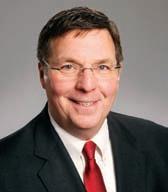

Jeff Koplan, MD, MPH, Vice President, Global Health, and Director, Global Health Institute, Emory
Sandra Mackey, Executive Director, Marketing Strategy and Support, Emory Healthcare
Kimberly Manning, Assistant Professor of Medicine, Emory
Paul Pendergrass, Independent Communications Consultant
Julie Ralston, Director of Communications, Atlanta Regional Commission
Walker Ray, MD, Retired pediatrician, former president of the Emory Alumni Association

Bill Todd, Executive Director for Health Care Initiatives, College of Management, Georgia Institute of Technology
Emory Medicine is published quarterly for Emory Healthcare patients and referring physicians, Emory School of Medicine alumni, Emory neighbors, affiliates of Emory’s medical community, faculty, staff, and other friends. Produced by the Health Sciences Communications Office, the magazine is made possible by support from the medical school dean and the Robert W. Woodruff Health Sciences Center Fund.
Please send correspondence to Emory Medicine, 1762 Clifton Road, Atlanta, GA 30322; call 404-727-0161 or email mloftus@emory.edu. For bonus multimedia features online, visit emorymedicinemagazine.emory.edu.
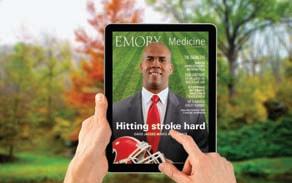
Download our iPad app.
Chris Larsen
Dean of Emory School of Medicine
John Fox
President & CEO Emory Healthcare
WINTER 2014
On our radar 2
2 | Screening for the “boy in the bubble” disease 3 | Proton therapy coming to Atlanta 4 | Seeing through a miniature implanted telescope 5 | Bipolar disorder: one patient’s story 6 | Top-10 national quality rankings 8 | Online portal for cancer answers 9 | Chronic stress and pregnancy 10 | New drug for advanced prostate cancer 11 | Assessing consumer genetic testing kits


Tackling stroke 12 Emory brings stroke patients the most advanced care in the narrow window of time when it can do the most good.

A drive through the Valley of Death 18
A new approach: The traditional model of drug development is no longer sustainable.


Ask, and tell 22




Starting with four basic questions, an Emory team is helping physicians and consumers nationwide understand the new health care law.
Behind closed doors 26 Women who are victims of intimate partner violence often are ashamed to talk about what they have been through. The privacy of a kiosk lets them disclose their abuse and find help. An editorial by Debra Houry.




212004-3 NEW
AND MORE
Visit us online at emorymedicinemagazine.emory.edu. Send letters to the editor to mary.loftus@emory.edu. 12 2 6 18
AND NOTEWORTHY FEATURES
Screening for SCID
Georgia parents may soon get the option to have their newborns screened for SCID, an inherited disorder commonly known as “boy-in-the-bubble disease,” marked by severe, chronic infections. The state’s Newborn Screening Advisory Committee voted unanimously to endorse the screening for Georgia. The next step is for Georgia’s Department of Public Health (DPH) to add the screening to the battery of tests it recommends hospitals give to all newborns. The SCID screening would be the first test added since cystic fibrosis screening was added 10 years ago.
The committee recommended adding the SCID screening after the state’s only pediatric immunologist, Lisa Kobrynski of Emory, presented information to the panel that although SCID was thought to be rare, newborn screening in nine other states has shown it to be relatively common: one in 40,000. Given nearly 140,000 births per year in Georgia, Kobrynski says that two or three babies are likely born with SCID in the state each year and that many cases of the disorder may have been missed. Deaths may be wrongly attributed to sudden infant death syndrome or other causes. The answer to this pressing problem, Kobrynski says, is to institute a newborn screening test for SCID, so that SCID can be diagnosed and babies treated in time.

Children with SCID cannot make T cells, a key part of the immune system’s defense against hostile bacteria and viruses. If children with the disorder receive bone marrow or peripheral blood cell transplants in the first six months of life, their immune systems are “rebooted,” enabling them to make their own T cells and protect themselves against infection. After transplant, most children can live normal lives without additional interventions. However, the timing of transplantation is crucial. If the transplant is done after the first six months of life, outcomes are not nearly as good.
Kobrynski, a Marcus Professor at Emory and director of the Jeffrey Modell Foundation Center for Excellence, is helping federal and private agencies develop clinical guidelines for the diagnosis and treatment of SCID. If the Georgia DPH adds the SCID screening test, Kobrynski will partner with them to provide follow-up care to infants who test positive for the disorder.—
Yael D Sherman
want more?
To learn more about the work of the Marcus professors in pediatrics, see bit.ly/marcusgiftemory
New treatment for severe dry eye


Dry eye can be a painful condition, causing light sensitivity, foreign body sensation, eye fatigue, and burning. Emory Eye Center is offering a new treatment to help relieve symptoms. The technology is called Lipiflow Thermal Pulsation, and it opens and clears blocked oil glands to allow the body to resume the natural production of lipids, which are needed for healthy tear film. The treatment applies heat to both inner eyelids, while applying gentle pressure to the outer eyelids causing the release of lipids from the blocked glands. It takes about 12 minutes and is virtually painless, and relief may last from nine to 15 months.

EMORY MEDICINE 2 ON OUR RADAR New and noteworthy
Proton therapy to be available in Atlanta

sit at the corner of Peachtree Street and North Avenue in midtown Atlanta.
Construction is well along on what will be the first facility in Georgia to offer the most advanced radiation therapy possible, proton beam therapy. The new 107,000-square-foot facility will
The Emory Proton Therapy Center–Winship Cancer Institute, being built by the San Diego-based firm Advanced Particle Therapy, is expected to treat approximately 2,200 cancer patients a year when it opens its doors in 2016. Once fully operational, the center will employ approximately 150 full-time proton therapy professionals, including radiation oncologists, medical physicists, and radiation therapists. In addition, researchers at Winship will collaborate with Children’s Healthcare of Atlanta and Georgia Tech in continued studies on proton beam therapy.
New web-based test can predict Alzheimer’s
Asimple visual test developed at Emory is likely to predict the onset of Alzheimer’s disease or mild cognitive impairment (MCI) three to six years before symptoms appear.
Researchers at Yerkes National Primate Research Center are fine-tuning a web-based test that gauges how long people view novel and repeat objects. The test can show whether a person is presymptomatic for cognitive decline or Alzheimer’s.

“This could be the thing that helps with a huge problem facing the so-called silver tsunami,” says Yerkes director Stuart Zola. “Hopefully, this will really have a positive impact on people’s lives and on public health. Wouldn’t it be wonderful if our grandchildren could grow up without the threat of Alzheimer’s disease?”
During years of research studies, Zola and co-developers Elizabeth Buffalo (Yerkes, neurology) and Cecelia Manzanares (Yerkes, neuroscience) found that monkeys and people—even those without any cognitive impairment—who focused equally on both the novel and repeat objects all developed MCI or Alzheimer’s within that three- to six-year window. People who already were diagnosed with MCI at the time of their testing and who focused on both objects equally went on to develop Alzheimer’s.
“If they were pre-symptomatic at the time of testing, then they were already on a trajectory,” Zola says.
The team, along with Eugene Agichtein (math and computer science), launched a company, Neurotrack, this past October to secure venture capital funding and to commercialize the technology. (The 2013 South by Southwest Interactive Festival named Neurotrack the year’s top webbased health technology.) While the team would eventually like to see the technology used in the doctor’s office, right now it is targeting pharmaceutical companies who could use the test to find people for clinical trials who are pre-symptomatic.
Clinical trials for Alzheimer’s treatments are difficult, Zola says, because companies or institutions must either choose subjects who have no symptoms but whose status is uncertain as to whether they will develop Alzheimer’s or choose people who are already symptomatic. “They may be overlooking a drug that could be useful because it’s too late in the game to give it to Alzheimer’s patients.” The test developed by Zola’s team provides the ability for the first time to select people who are pre-symptomatic but are on a trajectory for cognitive decline within several years and people who are pre-symptomatic and are not on that trajectory.
Winter 2014 3
Seeing time on the bedside clock


“My mother, my grandmother, my brother, and my uncle had macular degeneration. Then it came to me,” she says. Strickland is one of a handful of Emory Eye Center patients who have regained their sight due to a new FDA-approved implantable miniature telescope (IMT).
The surgery, covered by Medicare, is for patients with end-stage AMD who are over 75 years of age and have not had cataract surgery in the eye to be implanted. Emory’s researchers, who participated in the device’s clinical trials, will follow the patients for five years after implantation.
ress: “The good news is that she is seeing the fourth line on the eye chart.”


Eleanor Strickland, from Columbus, Georgia, was legally blind from the effects of age-related macular degeneration (AMD). The disorder had affected other members of her family too.
Before the IMT surgery, there were few options for patients with AMD. The implant is giving patients “the ability to do those everyday things we all take for granted, such as seeing the faces of family members,” says Emory cornea surgeon John Kim.
The patients who have received the implantable device so far have differed in what they experience after implantation. Some have had double vision as part of the healing process, “a good thing that lets us know input is truly coming from each eye,” says occupational therapist Donna Inkster. In Strickland’s case, Inkster already sees encouraging prog-
When your profession demands moral decisions
Consider Emory’s Master of Arts in Bioethics

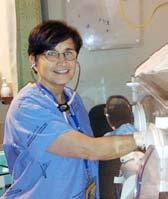


Advances in technology can save ever-smaller preterm infants. For Emory neonatologist April Dworetz, that’s the easy part. The tricky part is talking to parents whose children are at “the margins of viability.”
The high stakes of the situation require moral and ethical decision making. With families hanging on every word she says, Dworetz wants to get it right.
“I went into the bioethics program at Emory thinking I knew a lot about bioethics,” Dworetz confesses. “I am on the Grady Hospital Ethics Committee and have wrestled with ethical issues in clinical practice for more than 30 years, but realized that I needed a framework to do ethics right. Reading philosophy was a different language, a different way of thinking about things. I now know how important it is to look at ethical questions from various perspectives: cultural, religious, and values-based.”
Those family conversations that carry so much weight? Dworetz is doing her part to improve them. Her thesis involves writing scripts for how to talk to families whose infants have disabilities. Improve the quality of your crucial conversations.
The MA in Bioethics program provides you a competitive professional advantage, demonstrating that you have the interest in and capacity to address the most timely and challenging ethical issues facing your profession.
Apply today: ethics.emory.edu/mabioethics
The device adds approximately 3X magnification to all objects while leaving the other eye free to provide peripheral vision. Over time, the two eyes learn to work independently so that one eye can be used for mobility and activities and the telescopic eye for detail. To help patients through the process, “we do a lot of cheering and training,” Inkster says.
“Before the surgery, I had only peripheral vision,” Strickland says. “I wanted this surgery so I could read and recognize people. I have great faith in it.” —Sally Wolff-King
EMORY MEDICINE 4 ON OUR RADAR New and noteworthy
Listening to the patient
The songs on Tony Graham’s debut album fluctuate between a sad, wailing trumpet and playful vocals with warm guitar tones. With tracks titled “Manic Depression,” “Peace from the Battles,” and “Hypomania,” Graham’s album highlights the musician’s personal experiences with bipolar disorder. Graham brought these experiences to a psychiatry panel discussion on this topic at Emory last spring. The goal was to give insight into the disease to both care providers and families of those with bipolar disorder.

Graham has wrestled with depression and thoughts of suicide since junior high. But when he reached his 30s, stressful life experiences—a demanding career in the competitive car industry, a divorce, and moving between Miami and Atlanta— triggered more frequent and consistent episodes of depression and suicidal thoughts. At times, he would unexpectedly flip into a manic period “for days on end,” a double-edged sword that allowed him to endure the long hours required by his job but added more stress.
After three hospitalizations, Graham was finally diagnosed with bipolar disorder 2, a condition marked by moods that cycle between high and low, but the mania highs stop short of full manic episodes and depressive episodes are common.
A patient of Emory psychiatrist Jeffrey Rakofsky since 2010, Graham has kept a balance with the help of psychotherapy, medication, music, and his children. Rather than stay quiet about his struggles with mental illness, Graham is speaking out about his condition and using his first album, Mood Swings, to reduce the stigma often associated with bipolar disorder “one note at a time.”—
Cole Youngner
The treatment of malaria faces a double-whammy: the parasite that causes malaria is becoming resistant to the most effective drugs against it, and some forms of the parasite can persist in the liver and only emerge to infect the bloodstream (and cause symptoms) weeks or even years later. The Emory Vaccine Center and Yerkes National Primate Research Center are studying molecular details of how malaria parasites interact with people in hopes of finding patterns that can predict the course of the disease. Their work also could help physicians identify biomarkers to predict which cases will become the most severe and help inform the design of a malaria vaccine. This work is part of the Malaria Host-Pathogen Interaction Center, funded by up to $19 million from the NIH, which brings together Emory scientists with partners at University of Georgia, Georgia Tech and CDC and is led by Emory malaria expert Mary Galinski.
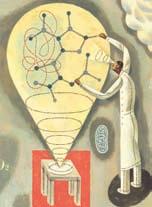
The Winship Cancer Institute and Emory’s Laney Graduate School have started a cancer biology research program to train the next generation of cancer investigators. While cancer research is progressing, it is a slow process. Many cancers are not the same diseases they were even a few years ago, and new subtypes of cancer continue to develop and confound the search for cures. The program includes training in molecular and cellular biology, genetics, signal transduction (how cells respond to an external stimulus), genetic engineering, and nanotechnology.

Winter 2014 5
Two Emory hospitals ranked in top 10 nationally for quality
The University HealthSystem Consortium (UHC), an organization comprising most of the nation’s leading academic medical centers, ranked Emory University Hospital second and Emory University Hospital Midtown third in the 2013 national Quality Leadership Awards.
The rankings honor top performers in UHC’s Quality and Accountability Study, which rates performance in the areas of mortality, effectiveness, safety, equity, patient centeredness, and efficiency.
2013 UHC top-10 ranked hospitals
1. NYU Langone Medical Center, New York
“Emory Healthcare [EHC] has been on a journey to redefine the quality of care and service we provide to our patients,” says John Fox, president and CEO of EHC. “These national rankings are indicative of our leading improvements in reducing mortality and infection rates and many other quality, safety, and service indicators that go into this overall ranking algorithm.”
2. Emory University Hospital, Atlanta
3. Emory University Hospital Midtown, Atlanta
4. Mayo Clinic, Rochester, Minnesota
5. Rush University Medical Center, Chicago
6. Beaumont Hospital, Royal Oak, Michigan
The UHC rankings are considered the most rigorous and non-biased in health care. This is the second consecutive year that these two hospitals have been ranked by UHC in the top 10, and Emory Healthcare is the only system with two hospitals in the top-10 rank.
7. Fletcher Allen Health Care, Burlington, Vermont
8. Ohio State University Wexner Medical Center, Columbus
9. University of Utah Health Care, Salt Lake City
10. University of Colorado Hospital, Denver
“One of the highest forms of recognition for an academic medical center is to be deemed a national leader in quality among peer institutions,” says William Bornstein, chief quality and medical officer for EHC. “We have been successful by instilling a culture of commitment to quality, safety, and service across the entire organization, and because of this we are able to perform more effectively for our patients and families.”
Nursing school and VA to train nurses for veteran care

The nursing shortage in the United States is expected to grow to 1 million registered nurses by 2025, and the largest employer of nurses in the country, the U.S. Department of Veterans Affairs, is aiming to stem the tide by trying to interest new nursing students in veteran care.
The Atlanta VA Medical Center (VAMC) is teaming up with Emory’s Nell Hodgson Woodruff School of Nursing to train nurses for the specialized field of veteran health care. They recently received a $4 million grant from the U.S. Department of Veterans Affairs to fund 10 additional faculty positions at the nursing school and increase the undergraduate class by 100 students over a five-year period. Students admitted during this partnership will be part of a two-year cohort focused on veteran care and will participate in clinical rotations at the VAMC
EMORY MEDICINE 6 ON OUR RADAR New and noteworthy
Summon your potential with a Juris Master degree



The intersection of law & healthcare


The Juris Master (JM) is a customizable 24-credit-hour program that is designed to enhance your knowledge of the law within your chosen profession or industry. Scholarships available.

Learn more at www.law.emory.edu/jm

“The Juris Master program will help me provide better care to my patients, better education to my trainees and better service to the University.”
— Dr. Wendy Wright, medical director of Emory Hospital’s Neuroscience ICU and associate professor of neurology and neurosurgery at Emory University School of Medicine
Get answers to your cancer questions


Winship Cancer Institute has developed “Whiteboard,” an online portal to post questions about cancer and get an answer back from Winship cancer experts. Questions can be submitted at advancingyourhealth.org/whiteboard and typically are answered within two days.
Won’t you like us?
The Emory School of Medicine is now on Facebook at www. facebook.com/EmoryMedicine. “Like” the school to keep up with the latest in education, biomedical research, and patient care. Become a fan today!


EMORY UNIVERSITY CHILD STUDY CENTER

Testing vaccines for pandemic flu


Researchers at Emory and Children’s Healthcare of Atlanta will be testing a vaccine for H7N9 flu, the strain that sickened 135 people in China last spring and killed 44, or 32%. The NIH is sponsoring the clinical trial through the Emory Vaccine and Treatment Evaluation Unit (VTEU) and seven other VTEUs around the country.
Most of those stricken with the new avian flu strain last spring had had contact with poultry. While their median age was 58, four cases were confirmed in children. “This trial is important because humans have not developed any immunity to this newly identified virus,” says infectious disease specialist Mark Mulligan. H7N9 has not spread easily between people and has not yet been detected in the U.S., but there is concern about its potential to create a global pandemic.
How do children learn language? What helps form their memories?
How do they understand the world around them?
The Emory University Child Study Center invites families with infants through schoolage children to be part of studies focused on typical child development.


http://www.psychology.emory.edu/childstudycenter
Seeking Local Families for Child Development Studies
Interested in participating?
We hope you will join us in our efforts to find out how typical infants and young children develop.

EMORY MEDICINE 8 ON OUR RADAR New and noteworthy
Chronic stress in pregnant African American women leads to biological changes


Researchers at Emory’s Nell Hodgson Woodruff School of Nursing have identified underlying biological changes among minority and low-income pregnant women that occur in response to chronic stress. The women had elevated levels of cortisol, a major stress hormone, and their bodies had reduced ability to control inflammation. Inflammation and elevated free cortisol during pregnancy are associated with significant adverse maternal and infant outcomes, including preterm birth, hypertension, diabetes, preeclampsia, and miscarriage.
The women had elevated levels of cortisol, a major stress hormone, and their bodies had reduced ability to control inflammation.
“With 30,000 more African-American infants born prematurely each year compared to Caucasian infants, it is very clear there is a difference in birth outcomes in the United States,” explains researcher Elizabeth Corwin. “This health disparity appears related to the exposure of minority and low-income women to chronic stress, which wears on the health of these women prior to pregnancy as well as during and after pregnancy.”
VOLU NTEE R TO ASSIST WITH GEORGIA’S DISASTER RECOVERY
SERVGA is a statewide secure database of pre-credentialed healthcare professionals and other volunteers who want to help in case of a public health emergency.

SERVGA integrates governmentsponsored local, regional and statewide volunteer programs to assist emergency response and public safety organizations during a disaster.
Registering at www.servga.gov is quick and can be done within minutes. Name, address, contact information and occupation type completes the initial registration process. In order to be eligible, Responders are also encouraged to complete a Profile Summary.
To register for SERVGA, go online to: ww w.servga.gov.
When you register, you will need to agree to the terms of service, and then will be asked to provide information specific to you and your skills. This information will be used to establish your emergency credentialing level and to contact you in the event of an emergency.
For additional information e-mail the SERVGA system coordinator at servga@dhr.state.ga.us




Winter 2014 9
Winship now offers new radioactive therapeutic agent for prostate cancer patients
Winship Cancer Institute has treated the first patient in Georgia with a new FDA-approved radioactive therapeutic drug for advanced metastatic prostate cancer. The patient received a single injection of radium Ra 223 dichloride (brand name Xofigo), the first of six injections. Xofigo has been shown to reduce bone pain and improve quality of life.
“Radium Ra 223 mimics the behavior of calcium and is attracted to bone. Because of this process, the radium, in a high-energy state, kills cancer at the bone level so the bone can recover,” says Peter Ross, medical director of radiation oncology at Emory Saint Joseph’s Hospital, where the treatment took place.
Bone is the most common site to be affected by metastatic cancer, and bone metastases are particularly prevalent in prostate cancer. Approximately 90% of patients with metastatic prostate cancer show evidence of bone metastases, which is the main cause of death in patients with prostate cancer.

Patients usually have been treated with chemotherapy, with modest results. Radium Ra 223 dichloride has been shown to improve survival rates in patients by 30% while treating symptomatic bone pain, with few side effects.
Xofigo is the first and only alpha particle-emitting radioactive therapeutic agent approved by the FDA that has demonstrated improvement in overall survival rates. In the coming months, Winship clinicians will offer Xofigo injections to patients at other Emory hospitals as well.
Working together on the Accountable Care Unit
The old model of patient care: nurses and doctors, for the most part, worked independently of each other. The new model at Emory Healthcare: nurses and doctors spend their entire shift in the same unit, working side by side, and together, are responsible for the unit’s patient outcomes. Welcome to the accountable care unit (ACU).
ACUs have a set team of nurses and physicians that are managed jointly by a nurse and physician. The unit is responsible for its clinical, service, and cost outcomes.

For example, one clinical measurement, the rate of pressure ulcers, traditionally fell to nurses to manage and improve. On an ACU both nurses and physicians work together to prevent or manage patients’ symptoms and reduce the rate for the unit.
The ACU model has been under way at Emory for the past three years, and both physicians and nurses give the model high marks. “Employee engagement was blown out of the water,” says RN Bryan Castle, unit director for 6G at Emory University Hospital. “It’s the first time in surveys that I’ve seen that 100% of the nurses felt like they had a collegial relationship with the physicians they work with on the unit.”
“We have real work relationships now,” says hospitalist Jason Stein. “Everyone knows everyone and something about each other. We’ve had a lot of people observe our unit, and they often remark how quiet it is. Phones and pagers are used less—there’s much more face-to-face. There’s a certain calm and order.” Stein and Castle have teamed up with Susan Shapiro, system director of research and evidence-based practice in the nursing school, to advance the ACU model. Shapiro recently secured a three-year, $1.5 million grant from the Health Resources and Services Administration to evaluate the ACU model, train more staff nurses to lead unit-based teams, and develop a tool kit for other health systems on how to implement an ACU
Currently there are three ACUs at Emory University Hospital, one at Emory University Hospital Midtown, and one at Emory John’s Creek Hospital. Seven more are planned.
EMORY MEDICINE 10 ON OUR RADAR New and noteworthy
Number One





Emory University Hospital is ranked the number one hospital in both Georgia and metro Atlanta by U.S. News & World Report in the 2013-2014 Best Hospitals Guide. This is the second year in a row EUH has taken top honors.






Atlanta and Georgia


Lessons in doctoring Grandma
At 72, Bernadine Jones has hip and back problems and hypertension and has had multiple falls. She lives in a high-rise for seniors and needs help from a caregiver three times a week. A retired RN, Jones recently shared some insights about aging with a group of Emory residents in training.
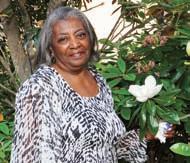
The residents were participants in the Chief Resident Immersion Training Program (CRIT) in geriatrics, which seeks to increase awareness among trainees about the complex challenges of caring for older patients.
Emory geriatrician Ugochi


Ohuabunwa directs the geriatrics clinic at Grady Hospital, where Jones receives her health care, and helped organize the gathering.
CRIT takes trainees from the nitty-gritty (a stethoscope placed near a patient’s ear can sometimes substitute for a forgotten hearing aid) to the broad idea (be aware of age-ism). They learn about safety concerns in the hospital, with falls being first on the list, and they practice communication skills through role-playing exercises.
The conference is just the beginning of the year-long program. The residents are expected to disseminate what they’ve learned to others on their teams. They also will complete a research project related to older adults. Surgery chief resident Katherine Williams, for example, is pursuing a program to educate physicians about the important role of physical therapists in encouraging early ambulation in patients after surgery. Emory geriatrician Jonathan Flacker, co-investigator of the CRIT, applauds the proposal. “You are brave,” he says, “because you are taking on hospital culture. But this is an important project because it reduces length of stay and can lower readmissions.”
—Rhonda Mullen
Results vary in genetic home test kits



















Researchers at Emory’s Rollins School of Public Health analyzed and compared DNA test results from three directto-consumer personal genome testing companies (23andMe, deCODEme, and Navigenics) and found that results not only varied from company to company but were contradictory for certain traits in certain individuals. The complete findings are available in the online edition of Genetics in Medicine.
“Although two of the companies that we studied are no longer operating, genotyping and sequencing is becoming less expensive, and testing such as this is increasingly popular,” says epidemiologist Cecile Janssens, who led the study. “The methods used for predicting these types of results are an important concern.”

Using the prediction methods of the three companies, which were obtained from their websites, the Emory team calculated predicted risks for six diseases: type 2 diabetes, prostate cancer, celiac disease, Crohn’s disease, age-related vision loss, and abnormal heart rhythm.
The variations in predicted risks were explained by several factors, including the fact that the three companies applied different mathematical formulas. The formulas of two companies led to an overestimation of risks and even predicted risks that were higher than 100%.
“Our study provides insight into the methodology and performance of risk estimation for personal genome tests,” says Janssens. “Future efforts to design predictive models will benefit from understanding the strengths and limitations of these current models and formulas.”
11 Winter 2014
Patient Bernadine Jones, 72, shares her perspectives on aging with residents in training.
CHARLIE WATTS
tackling stroke
It can come on slow or fast, surprising young and old alike. No matter, Emory brings patients with stroke the most advanced care in the narrow window of time to do the most good.
By Sylvia Wrobel n Photography Jack Kearse
EMORY MEDICINE 12
In 2001, during “the best season a defensive lineman could ask for,” David Jacobs began suffering severe headaches after a particularly hard-hitting University of Georgia ( UGA ) game. He felt dehydrated, despite intravenous fluids. He was lethargic and out of it, says girlfriend Desiree, now his wife and mother of his two young sons. But he wanted to tough it out.


Four days later, after an intense practice, Jacobs’s right arm suddenly went numb. His eyes turned bloodshot, and the headache worsened. He passed out and had to be revived. He remembers teammates calling, “David, David, what’s wrong?” He remembers thinking the ambulance driver would get in trouble for going so fast.
That evening in Saint Mary’s Hospital in Athens, he felt spacey, but the next day things went from bad to worse. He couldn’t move or talk. A CT scan showed damage to the lining
of the vertebral artery, probably from a blow to his head during practice. A clot had broken free and lodged in his brain. When doctors said they were transferring him to Emory University Hospital (EUH), his first thought was, “in rush hour traffic?”


Today, having become an unintentional expert on stroke care, Jacobs knows that hospitals are connected by protocols and helicopters and that he probably owes his life not only to Emory’s stroke program but also to doctors at Saint Mary’s. “As a hospital that
Stroke is the third leading cause of death in the country and even higher for those in the “buckle of the stroke belt.” Emory brings comprehensive clinical, rehabilitation, and research programs to tackle stroke.
Winter 2014 13 THE take-away
stroke
Winning the big game: A stroke took David Jacobs off the football field, but he recovered to have a new career and start a family (shown here with his wife, Desiree, and their two sons).
ability to swallow, speak, and move after stroke.
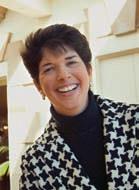
Stroke primer
Sometimes called “brain attack,” stroke occurs when blood flow to the brain is disrupted, depriving cells of oxygen.
Ischemic strokes are caused by blood clots, often the result of plaque buildup.
Hemorrhagic strokes occur when a vessel bursts, leaking blood into the brain. David Jacobs’s stroke followed an injury that tore a vessel, but some people have weak spots (aneurysms) or malformations in brain blood vessels.
Transient ischemic attacks (TIAs, or ministrokes) are brief interruptions of blood supply to the brain. Symptoms are similar to those of other strokes but often may be of shorter duration and come and go. TIAs can be warning signs of an impending major stroke.
treats lots of strokes, they could have been all ego,” Jacobs says, “but instead they looked at me and said we need to get this kid to the specialists.”
Jacobs woke up in Emory’s ICU, surrounded by white coats, family, and coaches. If clot-busting medicine failed to work, surgery was an option.
That proved unnecessary, but Jacobs’s battle had just begun. His right side was paralyzed. He says, “The week before I was on the field like a gladiator. Now I was like a baby, having to relearn everything.”
How to walk, use a pencil, talk without slurring words. Football taught him to be strong, but when a physical therapist asked him to lean on his elbows, it was the hardest thing he had ever tried to do.
He spent a month in EUH, three months in therapy at the Emory Center for Rehabilitation Medicine, more months in daily rehab with a UGA athletic trainer. Jacobs returned frequently to Emory for checkups and later to visit the clinicians and therapists who had become like family.
He received motivation from not only his clinical team but also UGA Coach Mark Richt (later godfather of the Jacobses’ firstborn) and his teammates who took those first steps with him around the hospital during his recovery. A year after his stroke, at the pregame entrance of the UGA/Georgia Tech game, a fully-suited Jacobs got a thunderous standing ovation when he jogged out to midfield with his teammates.
He would never play football again, but today the successful mortgage account manager often returns to UGA—and to high schools, churches, and community centers across Georgia—to talk about stroke and the importance of quick response. He volunteers at hospitals and serves on Children’s Healthcare of Atlanta’s board. He recently headlined a 5K race at Saint Mary’s to raise awareness for the disease that
threatened his life. Just by standing there, says Desiree Jacobs, her husband is proof of what good treatment and determination to do the long, hard work of rehabilitation can do.
A decade ago, when Jacobs was referred to Emory, a sea change was occurring in stroke treatment—and Emory doctors were at the forefront of the changes.
The FDA approved the clot-busting tissue plasminogen activator (tPA) in 1996, following national clinical trials involving Emory doctors. One of those, neurologist Michael Frankel, has directed Emory’s Vascular Neurology program for the past decade and now also directs the Marcus Stroke and Neuroscience Center at Grady Memorial Hospital, established with a multi-million dollar gift from the Marcus Foundation.
In 2002, with support from MBNA America (since acquired by Bank of America), a new Emory Stroke Center pulled down departmental walls between neurologists, neurosurgeons, radiologists, and other specialties involved in stroke diagnosis and treatment, integrating stroke care in a model of cooperation copied nationally. Founder Daniel Barrow, MBNA/Bowman Chair of Neurosurgery, remains director, with neurologist Fadi Nahab as the medical director.
As patient volume increased, so did sub-specialization. Barrow, for example, now spends most of his time on aneurysms and blood vessel malformations of the brain and spinal cord. Volume translates to experience, and experience to better outcomes. EUH has become one of the largest referral centers in the country for hemorrhagic strokes. But whatever complicated problem arrives at the door, the team has taken care of it many times over, achieving mortality ratios well below those of the region and nation despite a disproportionate share of complex cases.
Stroke patients have special monitoring and treatment needs. Many have coexisting medical conditions. Complications can involve other organs—and may require the care of cardiologists, endocrinologists, pulmonologists, or other specialists. Emory’s
Samuels was Georgia’s first neuro-intensivist, a subspecialty that coordinates neurologic and medical management of critically ill patients. He created one of the country’s first neuro-critical care services at EUH, where staff now include eight fulltime neurointensivists and 19 neuroscience-trained nurse

EMORY MEDICINE 14
Owen
Emory rehab director Catherine Maloney helps patients regain the
Emory neurologist Michael Frankel helped discover the clot-busting properties of tPA to treat stroke in the 1990s. Head of the Marcus Stroke and Neuroscience Center at Grady, he currently leads a national NIH study to evaluate blood biomarkers in at-risk patients.
practitioners. Emory’s 20-bed neuro-ICU opened in 2007, centralizing critical medical services and technologies for patients suffering stroke and other severe neurologic problems. As described in a front-page Wall Street Journal article, unlike traditional ICUs that work to keep visitors out of the way, the high-tech Emory neuro-ICU comes with family living quarters and a staff of clinicians who bring families into medical conversations. As a result, outcomes have improved.
In April and July, respectively, the programs at EUH and Grady became the first in North Georgia to receive Comprehensive Stroke Center certification from the Joint Commission, the accrediting body for all U.S. hospitals. This highest possible rating recognizes institutions with specialists, programs, and clinical resources to treat stroke patients of any complexity, around the clock, with accuracy and speed.
In addition, EUH Midtown, Emory Johns Creek Hospital (EJCH), and Emory Saint

Joseph’s Hospital (ESJH) are now Advanced Primary Stroke Centers. Emory-affiliated Southern Regional Medical Center also holds Advanced Primary Stroke certification. Each year, among EUH, EUH Midtown, Grady, EJCH, and ESJH, Emory clinicians treat roughly a quarter of the 20,000 stroke patients in Georgia. EUH and Grady are two of the nation’s highest-volume hospitals for acute stroke, each admitting roughly 1,000 patients per year, the majority at Grady for ischemic stroke (which accounts for 87% of all strokes) and the majority at EUH for the rarer but potentially more devastating hemorrhagic strokes.
The unusually high number of primary certified stroke hospitals in Georgia owes much to being part of the first wave to join the Paul Coverdell National Acute Stroke Registry. Established in 2001 and named for the Georgia senator who died of stroke while in office, the registry tracks hospital
stroke care and shares best practices. It is based on a prototype implemented at Grady by Emory medical faculty. Fadi Nahab believes that cooperation between the expanding network of “stroke-ready” hospitals and the increasingly coordinated transfer and transport system that quickly gets patients to the right level of care is “one of health care’s great emerging success stories.”
More than half of Emory’s acute stroke patients are transferred in, most by helicopter, from other hospitals seeking specialist care for patients. The rest come through the Emory emergency department, where emergency medicine physicians work closely with colleagues in stroke. Emory and Grady stroke teams also work closely with emergency medical service personnel to help them recognize stroke symptoms and decide where patients should be taken.
To be effective and prevent damage to the brain, tPA must be given within a short window of time. Emory already has a “doorto-needle time” of within 60 minutes for
Winter 2014 15
David Jacobs works to raise awareness of stroke and the importance of quick response by participating in community events across Georgia.
the majority of ischemic stroke patients for whom tPA is appropriate. The goal now, says Nahab, is to shorten “first medical contactto-needle” time.
The Emory team accomplishes this quick intervention through every means possible, depending on the type of stroke or risk. This includes injecting tPA in a vein in the arm or using a catheter to release it directly into the area of the brain where the stroke is occurring. More often, it involves pulling clots through a catheter. Or performing surgery or coil embolization to prevent blood leakage or bursting of aneurysms. Or using surgery to repair (or radiation to shrink) arteriovenous malformations (a tangle of faulty arteries and veins that can rupture within the brain). More than 50 ongoing research projects by Emory investigators also develop and test new treatment methods and devices, providing patients with access to clinical trials. For example, a nationwide study known as TREVO-2—headed by Emory neurologist Raul Nogueira, who directs neuroendovascular services for the Marcus Center—led to FDA approval of a new clot-removing device in 2012. When no treatment options seem to exist, Emory doctors go looking for other answers. For example, a patient recently referred to Emory had an aneurysm so large and delicately placed that repairing it

required stopping blood flow to the aneurysm—and thus to the brain—for a full 15 minutes, which ordinarily would result in a neurologic disaster. However, working with Emory cardiac surgeons, Barrow put the patient on bypass machines used in openheart surgery, cooling her body to the point where, as sometimes happens when a child falls into an icy lake, the woman’s brain slowed so much that her oxygen demands plummeted. The team made the repair, restarted circulation, and the patient—untreatable by any standard method—went home healed and with normal function.
After stroke, most patients require at least some rehabilitation, says Catherine Maloney. She heads the Emory Center for Rehabilitation Medicine (CRM), where stroke affects the largest percentage of the 650 inpatients and 1,600 outpatients treated annually.
Rehabilitation often begins in the EUH neuro-ICU, where rehabilitation specialists evaluate swallowing and other immediate critical problems and determine ways to quickly re-engage damaged neural pathways. These patients and others referred from across the state go on to intensive inpatient and outpatient therapy in the CRM. Many participate in groundbreaking research such as that by neuroscientist and physical therapist Steve Wolf that was
the first to show the benefit of constraintinduced therapy to improve post-stroke recovery.

Once patients are largely functional, CRM “post-graduate” specialty clinics finetune specific speech, cognitive, or mobility problems. One clinic focuses on aphasia, difficulty in reading or finding the right word. Another provides driver evaluation and training to get patients back on the road. Others focus on strength and balance problems with therapy on stairs, rails, or in the heated water of an adaptive pool. In the wheelchair clinic, therapists work with patients and vendors to customize chairs for maximum independence. Personalized therapy helps with simple but life-affirming tasks like putting on mascara or firing up the backyard grill.
Emory patient Susan McKessy “totally gets rehab.” A year after retiring from the Coca-Cola Company, McKessy, then 55, inexplicably found herself lying on the floor, vomiting, with the worst headache of her life. She crawled to a phone and asked the friend for whom she was babysitting to come home. She assumed she had contracted a virus, to which she didn’t want to expose the newborn.
Although McKessy drove herself home, she did accede two days later to her sister’s suggestion to see a doctor. Her internist at Piedmont Hospital took one look at his
EMORY MEDICINE 16
Susan McKessy (above left in pink and right in orange) rebuilt her life after stroke at Emory’s Center for Rehabilitation Medicine. Today she volunteers at the center, where she works alongside several of the clinicians who helped her during recovery.
patient and had McKessy taken immediately to the emergency department. “Apparently my brain and mouth were not working at the same speed,” says McKessy. A CT-scan showed bleeding in her brain. McKessy arrived at Emory at 2:30 p.m. for an angiogram that within an hour had outlined a bulging aneurysm. Two hours later, she underwent what she calls “rocket science surgery,” in which interventional neuroradiologist Jacques Dion snaked platinum wires through blood vessels to her brain to create delicate coils that sealed off the aneurysm.
Placed in a coma to give her agitated brain time to rest, McKessy remembers nothing of the surgery nor of the following days in the neuro-ICU. After weeks of rehabilitation, when she “met” Owen Samuels, who had participated in her immediate care, she didn’t remember him. He almost didn’t recognize her either, so completely had she recovered.
Still, it wasn’t easy. Now a volunteer at the CRM, McKessy often shares her own story with patients— how a physical therapist had told her, yes, she understood that McKessy didn’t want to do therapy because she was tired, sleepy, discouraged, etc., but none of these excuses would help her improve. I’m going to count to three, the therapist said. When she got to two, then two and a half, exactly as McKessy’s mother used to do, McKessy found herself painfully shifting her legs over the side of the bed. “It was a turning point,” she says. “I realized they were the experts, but I had to do the work. And here I am.”
Stroke care is a continuum, from getting patients to the right care to returning them, as well as possible, to families and communities. Comprehensive stroke centers also have responsibility for helping prevent first or second strokes. That means providing intense clinical followup to patients at a multidisciplinary clinic or making sure they are reconnected to medical follow-up in their own communities. It means identifying persons at risk. For example, one Emory program—involving emergency medicine, cardiology, neurology, and radiology colleagues at EUH, EUH Midtown, and Grady—evaluates people who have had a TIA to help them modify risk factors to avoid a full-blown stroke. And it means education on how to recognize and respond to stroke. Every year, Emory stroke nurses provide presentations and screenings in community churches and centers, often at the request of former stroke patients. Prevention also means research to figure out why certain people are at higher risk of
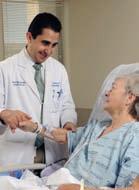
Fadi Nahab is medical director of the Emory Stroke Center, one of 30 centers nationally to have Comprehensive Stroke Center Certification.
Emory neurosurgeon Dan Barrow spends much of his time on aneurysms and blood vessel malformations of the brain and spinal cord.
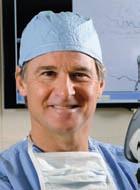
stroke. Frankel, for example, leads a national NIH study to evaluate blood biomarkers in at-risk patients. Nahab’s research has focused on how nutrition and diet may explain why Georgians, especially African Americans, are at greater risk for stroke.
And like clinical care, much Emory research involves teamwork. “I can’t say the word partnership often or emphatically enough,” says Nahab, describing his physician, nursing, and other clinical and research colleagues and speaking of the hospitals across Georgia with whom Emory shares patients. “And when I think of how working together is improving care for stroke patients, I always say it with gratitude.”
Patients like David Jacobs have their own words of gratitude. When it comes to high-level care and involvement with individual patients, Emory has it down to a T, he says. But if Jacobs knows more than he ever wanted to about stroke care, he acknowledges even more the value of teamwork. To win this game, he knows, is going to take regular people recognizing both the symptoms of stroke and the need for prompt action—and doctors and hospitals working together to get patients to the level of care they need. As legendary coach Vince Lombardi once said, “People who work together will win, whether it be against complex football defenses, or the problems of modern society.”EM
Stroke symptoms
Sudden occurrence of

n Numbness or weakness of the face, arm, or leg (especially on one side of the body)

n Confusion, trouble speaking, or understanding speech
n Trouble seeing in one or both eyes
n Trouble walking, dizziness, loss of balance or coordination
n Severe headache with no known cause
Risk factors include high blood pressure, diabetes, high cholesterol, heart disease, smoking, obesity, and family history. Age increases risk, as does being African American.
People who live in the stroke belt (southeastern United States) are more likely to have and die of stroke. Georgia, North Carolina, and South Carolina are the “buckle of the stroke belt,” with even higher mortality, twice that of the country as a whole. Socioeconomic status and race are not, as previously believed, enough to account for this difference.
want more? STROKE RESOURCES To see a video with the Jacobs family, visit emoryhealthcare.org/strokestory. For more information on the Emory Stroke Center, visit emoryhealthcare.org/stroke/index.html. To learn about support opportunities, contact development officer Katie Dozier at 404-712-2211 or katie.dozier@emory.edu.
Winter 2014 17

EMORY MEDICINE 18
DRIVE through the “valley of death”
By Quinn Eastman n Illustrations by Noma Bliss
THE take-away
When Dennis Liotta* makes such a proclamation, it carries weight. Together with his Emory colleague, Raymond Schinazi,† Liotta discovered some of most successful anti-HIV drugs as well as founded and advised an array of biotechnology companies. Along with other experts on drug discovery, Liotta is concerned about a growing gap between academic and clinical research. In fact, the transition from laboratory success to human clinical trials has become so difficult that former NIH Director Elias Zerhouni has dubbed it the “valley of death.”
A new initiative is rerouting the journey of getting drug discoveries from the laboratory to patients in the clinic by skillfully navigating the risks and cost hurdles along the way.
Winter 2014 19
“The traditional model of drug development is no longer sustainable.”
*Samuel Candler Dobbs Professor of Chemistry +Francis Winship Walters Professor of Pediatrics
“People in the field joke that we have been 10 years away from having a vaccine for the last 20 years,” says Gonzalo Vazquez-Prokopec, an environmental scientist at Emory who studies how dengue is transmitted from person to person. “It’s definitely a complex landscape for vaccine development.”
University labs excel in discoveries about basic chemistry and biology: studying cells and enzymes and examining models of human diseases in animals. Conventionally, after these discoveries are made, the task of testing the potential drug in humans falls to industry.
But in the past few years, pharmaceutical firms have begun to shy away from sponsorship of early clinical research. Citing increasing risks and costs—the expiration of patents, cost pressures from health care reform, regulatory stringency, and rising costs of clinical trials—pharma leaders are instead focusing on drug candidates that already have made it past some of the early regulatory hurdles.
Small start-up companies are supposed to fill the void. One such company, Pharmasset, was founded in 1998 by, among others, Schinazi and Liotta to discover and develop antiviral drugs. In 2012, Gilead (Nasdaq: GILD) acquired Pharmasset for $11 billion. However, for every successful start-up, there are a dozen or more failures. Companies founded on brilliant ideas may still have difficulty finding funding, may run out of money after encountering regulatory snags, or fail due to lack of an experienced management team to create value and navigate the abyss between funding and product development.
One result of these barriers is fewer clinical trials. According to the clinical trial industry association CenterWatch, the number of clinical trials listed on clinicaltrials.gov, including U.S. and international studies, declined in 2012 to a four-year low.
These developments frustrate researchers like Liotta and his colleagues, who have recently identified compounds in the laboratory that they think could be effective in fighting viruses such as dengue, West Nile, respiratory syncytial virus, and hepatitis C.
To bring these compounds closer to becoming drugs, he and Emory leaders are exploring a different approach. By combining academic, business, and operational capabilities, Drug Innovation Ventures at Emory, or DRIVE, may be able to withstand the harsh financial climate while following the most successfully traveled route across the valley of death.
An alternative route

Universities across the country have established centers for drug
discovery, most of which focus on sorting through vast collections of potential drugs to find a handful that show promising results—or “hits”—in laboratory tests.
DRIVE is different. It will take on a task that academic laboratories have generally been unable to do.

The risky and expensive part of drug development is not in finding the hits but rather in seeing whether the potential drug will have the desired effects in humans. Does the drug stay in the body long enough to do good? Does it get to the right organ? Does it damage the liver or kidneys? What is the maximum tolerated dose? Can it be manufactured on a large scale and cost-effectively?
This part of the process is expensive partly because the FDA requires a cache of safety data before allowing a new drug to be tested in humans. Grants from the NIH, which make up the bulk of university research funding, do not cover costs for these studies.
In the past, Emory—like other academic research institutions— has licensed promising research to start-up companies through its Office of Technology Transfer and hoped for the best. DRIVE will allow Emory to manage the process longer and possibly reap a greater return on investment.
For example, DRIVE will have the independence to do some things that traditional university entities can’t, such as license technology from other universities and combine it with technology from Emory, says CEO George Painter. At the same time, DRIVE will have capabilities that standard commercial firms lack, such as access to Emory’s research infrastructure, which includes the Emory Institute for Drug Development (EIDD). Although the organization will be capable of forming for-profit spin-offs, it is set up as a nonprofit to allow funding access from philanthropic foundations.
“We’re not trying to become a pharmaceutical company,” Liotta says. “We want to do this in a way that is compatible with the mission of the university.”
DRIVE is following a path similar to that taken by nonprofit groups such as the Michael J. Fox Foundation for Parkinson’s Research, the Cystic Fibrosis Foundation, and the Multiple Myeloma Research Foundation. These charities have ventured into the area of sponsoring drug development because they want to accelerate the process from bench to patient. Rather than strategically injecting money, however, DRIVE will be geared toward developing products.
Starting with dengue
One of the viruses that DRIVE will target is the tropical disease dengue, which is a growing public health problem. Transmitted by mosquitoes, dengue can cause fever, headaches, rash, severe muscle and joint pain, and even death.
Research for a dengue vaccine has been complicated. Last year, a large clinical trial in Thailand that tested the most advanced vaccine candidates against dengue announced disappointing results. The vaccine’s efficacy was only 30%, in part because it failed to protect against one type of dengue virus that was the most prevalent in Thailand at the time of the study.
EMORY MEDICINE 20
“People in the field joke that we have been 10 years away from having a vaccine for the last 20 years,” says Gonzalo Vazquez-Prokopec, an environmental scientist at Emory who studies how dengue is transmitted from person to person. “It’s definitely a complex landscape for vaccine development.”
An additional twist is that if someone gets sick with one strain, recovers, and later becomes infected with another strain, that individual is at higher risk for severe forms of the infection that involve internal bleeding, shock, and potentially death. This complexity is a powerful rationale for developing antiviral drugs against dengue.
Over the past 50 years, the incidence of dengue around the world has increased 30-fold, driven by urbanization and population growth. In 2009 and 2010, dengue fever re-emerged for the first time in decades in the United States with an outbreak in Florida. Liotta calls dengue a “disaster waiting to happen.”
Although dengue already is an existing problem in many countries, it is categorized as an emerging disease. This means that government agencies—such as the U.S. Department of Defense and others in South America and Southeast Asia—may be potential partners with DRIVE to develop a drug.
Navigating risks
Painter and Liotta return repeatedly to “de-risking” when describing the premise behind DRIVE. How exactly are they able to minimize risk in the drug development process?

Partly, it may come from a focus on antiviral nucleoside analogues, an area in which they have had past success. Nucleoside analogues are drugs that chemically resemble the building blocks of DNA and RNA (nucleosides). They inhibit the mechanism through which viral enzymes copy genetic material. An antiviral nucleoside analogue interferes with those viral enzymes more than it interferes with human enzymes, and those enzymes are similar enough across viruses so that one antiviral compound may have activity against another.
Because of past successes, “we’ve built up some credibility with potential investors there,” Painter says.
Another part of DRIVE’s “de-risking” comes from the breadth and depth of experience of its leadership. Painter, who holds undergraduate and doctoral chemistry degrees from Emory, has led antiviral research at commercial pharmaceutical companies, including GlaxoWellcome, Triangle Pharmaceuticals, and Chimerix. DRIVE’s Chief Scientific Officer, Abel De La Rosa, has led scientific and successful product development efforts at biotechnology companies (Digene, Boston Biomedica, Innogenetics, and Visible Genetics), and he spent almost a decade as senior VP of Business Development and Scientific Affairs at Pharmasset before its acquisition by Gil-
ead. DRIVE’s COO, David Perryman, has founded several biotech companies, including, most recently, Zirus, which is focused on host genetics of infectious diseases.
Even so, Painter acknowledges that decision-making in drug development often involves educated guesswork. He thinks of his job as the “pinball wizard,” who plays by intuition and sense of smell.

“Scientists are natural optimists,” he says. “They have lots of emotional investment in a project. One of the hardest things to do in the pharmaceutical industry is to kill a project, to know when to say ‘stop.’ It all comes down to good decision making during that time.”
In addition, another aspect of “de-risking” will come from government funding—for example, in the form of biodefense or preparations for emerging diseases. Commercial companies tend to lack interest in investing money for fighting diseases without a wellestablished market, but governments can look ahead.
For example, a decade ago, vaccine manufacturing moved out of the United States because of similar concerns about risks and costs. However, support from the Biomedical Advanced Research and Development Authority then led to construction of a Novartis vaccine manufacturing facility in North Carolina that will allow faster, more responsive flu vaccine production in cultured cells. Painter hopes DRIVE will become the recipient of a similar investment in emerging diseases and biodefense.
The EIDD already has received its first grant from the Defense Threat Reduction Agency, part of the Department of Defense, to develop drugs against equine encephalitis viruses. Spread by mosquitoes and found primarily in Central and South America, these viruses can infect humans and horses and are considered potential biologic weapons. The EIDD also is in the preliminary phases of collaborations on antiviral research with the University of Alabama, Georgia State University, and Saint Louis University. Through DRIVE, potential drug candidates from these projects can be shepherded efficiently through the clinical development path.
“We test-drove this approach before coming to Emory,” Painter says, “and we think we can make a valuable contribution.” EM
want more? To learn more about DRIVE, visit driveinnovations.org.
Winter 2014 21
FOUR Questions pro?ect
Starting with four basic questions, an Emory team is helping physicians and consumers nationwide understand the new health care law.
By Dana Goldman
Say a man will be eligible for Medicare in six months and needs a procedure. Should he wait? When can he sign up? Say a woman is a military veteran trying to figure out her health benefits. What do you tell her? On a recent Friday afternoon, Victor Wu is taking a group through a slideshow of case studies and complicated charts that cover this complex information. No matter that his audience members are highly educated health care faculty, residents, and students from
EMORY MEDICINE 22
ASK, AND TELL
THE take-away
medicine, public health, and allied health. Even this well-informed audience is having trouble navigating the intricacies of the Affordable Care Act (ACA), which mandates health insurance coverage for all Americans beginning in January 2014.
“You could probably boil all the feedback down to—‘I absolutely need to know this information, but it’s so overwhelming, and how can I learn it?’ ” says Wu, Emory’s chief resident of internal medicine at Grady Memorial Hospital. “My colleagues realize that understanding the new health care mandate is fundamental. But they don’t know where to go for reliable information.”

Wu was recently in the same position. He was unsure how to talk to his patients at Grady about their health insurance concerns since he wasn’t
confident in his ability to steer them in the right direction. When patients asked about the kind of plan they should choose, he felt clueless about what to tell them. “ ‘Go talk to a social worker,’ was not a satisfying answer for either one of us,” he says.
But after joining an Emory effort to figure out how to educate providers and patients about the ACA, Wu is in a better position to answer questions. He is one of the leaders of an all-volunteer Emory effort, “Let’s Ask 4.” The project seeks to enable providers and patients to talk together about health care reform through four basic questions: What are my choices for health insur-
“Let’s Ask 4” questions about the Affordable Care Act
1. What are my choices?
2. How do I get it?
3. How do I use it?
4. What will it cost?
Winter 2014 23
Understanding the new health care law is daunting to health care providers and consumers alike. A member of the Institute of Medicine’s Health Literacy Roundtable, Emory’s Ruth Parker (right) teamed up with chief resident Victor Wu and health literacy expert Kara Jacobson to develop a clearinghouse of accurate information and educational materials that will be distributed nationally.
ance? How do I get it? How do I use it? What will it cost?
A NEED TO KNOW The 4 Questions project emerged from an ongoing collaboration that is part of the Health Literacy Roundtable at the Institute of Medicine (IOM). Ruth Parker, an Emory professor of medicine and epidemiology, has been a roundtable member since its inception in 2006. In the past two years, she and her IOM colleagues have explored how to make it easier for the public to understand health care reform and implications of the new law.

“When it goes into effect in 2014, the ACA will create a whole new world of health insurance not only for physicians and other health care providers but also for the many Americans who have had little or no access to health insurance for months, years, or longer,” says the IOM’s Lyla Hernandez. “With the ACA on the horizon, it is essential that both health care providers and potential new insurance enrollees learn as quickly as possible about the new system.”
But learning about the new system is easier said than done. “Most people are overwhelmed because
by design, health insurance is very complicated,” Parker says.
Until now no one group has tried to create a clearinghouse of accurate information and educational materials that could be used by patients and providers. “The natural reaction when you see how complicated all of this is,” says Parker, “is to ask: ‘Who is going to figure this out? Call me when you do.’ ”
But Parker, who has long focused on health literacy, is not one to step away from a challenge. She knew that Emory, with a culture of collaboration between disciplines and access to patients, could serve as an ideal living lab for the project. She also knew that time was of the essence, that to accomplish the big goal, the team she was assembling would need to skip the grant-writing phase to apply for funding and plow ahead.
Wu, whom Parker describes as passionate about working to advance improved access to care, volunteered his time for the cause. He and a handful of Emory colleagues began trying to wrap their minds around health insurance and the ACA, all on a volunteer basis between work and school responsi-
EMORY MEDICINE 24
Kara Jacobson’s health literacy class at the Rollins School of Public Health collaborates with students in Emory’s physician assistant program to create prototypes of consumer guides for understanding the new health care law.
Although not everyone on the team agrees with all components of the new law, they do agree that its implications need to be understood and implemented. “This is not a political project,” Parker says. “It is about a law that will have tremendous impact on how we practice medicine and what health care and the use of health services look like. So what do we need to know and do?”
bilities, while Parker assembled a national advisory board to vet content.
The job was massive, involving hundreds of hours of culling material from various sources. “Information exists, but it doesn’t exist in just one place,” says Parker.

One volunteer on the team applied for Medicaid to make sure the group understood that process from the patient perspective. Others worked to understand the complexities of benefits for military veterans. Their goal was to understand the nuances of the health care system as it is now and how it will be beginning in 2014 so that they could explain answers to the four questions to providers and consumers. After initial presentations to providers, they asked for feedback about how clearly the information was conveyed.
Although not everyone on the team agrees with all components of the new law, they do agree that its implications need to be understood and implemented. “This is not a political project,” Parker says. “It is about a law that will have tremendous impact on how we practice medicine and what health care and the use of health services look like. So what do we need to know and do?”
TAKING IT TO THE STREET To include a consumer education component to make the information understandable, graspable, and usable, Wu and Parker enlisted the help of Kara Jacobson, a health literacy researcher and faculty member at Emory’s Rollins School of Public Health.
Jacobson’s health literacy class took on the consumer piece of the “Let’s Ask 4” project. Collaborating with Emory’s physician assistant (PA) program, the MPH and PA students created prototypes of consumer guides, with individual groups each tackling one of the four questions. The MPH students then brought those guides to Emory and Grady hospitals and community health facilities to get feedback from patients. Quickly they realized that most patients didn’t know about the ACA at all, much less its universal health insurance mandate. They also realized that small changes in wording could make a big difference in helping patients understand the new law.
“We really got down to the nitty-gritty,” says MPH student Maureen Clark. “Tell me what this word means to you? If you were to write this, how would you do it?”
Among the findings of Jacobson’s class: patients found the phrase, “making this amount of money or less,” easier to understand than the phrase, “making no more than this amount of money.” Similarly, the phrase, “employer-sponsored health insurance” was confusing to patients while “insurance through your job” made more sense.
“We did a lot of word-smithing,” says Jacobson. “Professionals in the health care field come at all of this information from such a different perspective than the person on the street. That’s why it’s critical that we don’t forget about the person on the street.”
MOVING THE COUNTRY FORWARD Four short months after their first meeting, Wu and Parker presented their progress to the IOM’s Health Literacy Roundtable. The response was positive, including that from Lyla Hernandez. “This project has developed materials that begin to fill the vast health insurance knowledge gap and to facilitate effective communication between providers and consumers,” she says. “Such communication is essential to enrolling the millions of Americans who will soon become eligible for health insurance coverage.”
The Emory team now is working to finalize a curriculum for providers and a guide for consumers. Team members plan to collaborate with the roundtable to draw attention to the effort from providers. The project contains four components, a short video, four PowerPoint slide sets for providers, a consumer guide, and an IOM discussion paper. The materials are available through the IOM Health Literacy Roundtable to download and use.
Parker is hopeful, albeit realistic, about the project’s impact. “This isn’t the magic silver bullet, some earth-breaking new endeavor that’s going to change our health care system,” she says. “But it is providing the tools and education and a baseline language for us to be able to move forward a shared conversation between patients and providers in our country.”
While the work continues, the “Let’s Ask 4” Project already is beginning to make an impact, starting at Grady. These days, Wu doesn’t worry about patients bringing up health insurance. Armed with answers to the four questions, he brings it up first. EM
want more? For more information, visit iom.edu/LetsAsk4.
Parker is hopeful, albeit realistic, about the project’s impact.
“This isn’t the magic silver bullet, some earth-breaking new endeavor that’s going to change our health care system,” she says. “But it is providing the tools and education and a baseline language for us to be able to move forward a shared conversation between patients and providers in our country.”
Winter 2014 25
THE take-away



Women who are victims of intimate partner violence are often ashamed to talk about what they’ve been through. The privacy of a kiosk allows them to disclose their abuse and find help.



EMORY MEDICINE 26 THE LAST WORD
On intimate abuse
Behind closed doors
By Debra Houry
During my residency training in emergency medicine, I routinely encountered patients with injuries that could have been prevented. I realized then that asking about safe storage of firearms, substance use, violence in the home, and other health-risk behaviors could help my patients after they left the emergency department. I also recognized that emergency physicians are often the only health providers with whom some patients interact. That is particularly true of victims of intimate partner violence, what used to be known as “domestic violence.”
One of the first patients who opened my eyes to this challenge was a young woman who had climbed through a window to leave a locked apartment and seek medical care after her partner left for work. She was embarrassed to talk about her situation. In fact, she failed to disclose the source of her injuries initially. When she did open up to me, I learned that she had been subjected to repeated, brutal beatings for months. Tragically, she thought she had done something to deserve the treatment. I was the first provider who had seen her since she had been in this abusive relationship.
Emory emergency medicine physician


Debra Houry works to prevent violence-related injuries and get women out of violent relationships. A researcher in emergency medicine and public health, she also directs the Center for Injury Control and is president-elect of the Society for Advancement of Violence and Injury Research.
Years later, I encountered a young mother who had sustained facial injuries and a wrist fracture from what she called a “fall.” When I questioned her further, she admitted that her boyfriend had caused the injuries. Still she was worried about what the boyfriend would do if she told anyone about the abuse, particularly because they had a child together. She came to the emergency
department only because of the severity of her injuries.
More recently, I saw a woman with chronic abdominal pain. Only after further questioning did I discover that her partner had raped her several months earlier. She had told no one, neither family nor friends, about the assault. These cases and more confirm for me that we need to screen women for partner violence in clinical settings.
Intimate partner violence is not a problem that happens outside our social circles or to others. Given that 25% of women have experienced physical or emotional abuse by a partner at some point, I am certain that if not you personally, then someone else in your life—a neighbor, a co-worker, a family member—has experienced intimate partner violence. Each day in the United States, three women are killed by a partner, and 24 people each minute are victims of rape, physical violence, or stalking by an intimate partner. Neither is intimate partner violence a one-time
25% of women have experienced physical or emotional abuse by a partner at some point
Each day in the United States, three women are killed by a partner
24 people each minute are victims of rape, physical violence, or stalking by an intimate partner
27 Winter 2014
Victims lose 8 million days of paid work a year, which equals about 32,000 full-time jobs
Of the 2,134 patients in a recent relationship, we found that 22% had experienced abuse in the past year
On intimate abuse


occurrence. The cycle of violence continues, escalates, and can ensnare others such as children. The health consequences are severe for abused women who have higher rates of hypertension, mental health symptoms, substance abuse, and infections than do women who have not been subjected to intimate partner violence. Further, victims lose 8 million days of paid work a year, which equals about 32,000 full-time jobs. Adding insult to injury, children who are the silent witnesses are more likely to become victims or perpetrators of partner violence if they are exposed to violence at home.
Although the Joint Commission on Accreditation of Healthcare Organizations requires hospitals to have policies and procedures in place to identify victims of partner violence and refer them to help, most clinicians are unaware of available resources, and they may fail to routinely screen for partner violence.

The Institute of Medicine recently released recommendations that preventive care should include screening and counseling for all women and adolescent girls for interpersonal violence. That sounds simple, but...
REDUCING STIGMA AND SHAME
is an inexpensive way to help patients who might otherwise fail to disclose abuse or other issues such as mental health symptoms or substance abuse problems.
For our original study, funded by the CDC and the NIH, we placed kiosks in the waiting room of the emergency department at Grady Memorial Hospital. Any patient who disclosed partner violence through a series of questions loaded onto the kiosk received an auto-generated list of resources. Of the 2,134 patients in a recent relationship, we found that 22% had experienced abuse in the past year. Among those we reached for follow-up at three months, 35% had contacted a community resource for partner violence.
With additional funding through the Avon Foundation, we replicated this work in emergency departments at Emory University Hospital (EUH) and EUH Midtown. Women at these sites reported similar rates of recent abuse and, like the women at Grady, they followed through to contact the suggested resources.
Among those reached for followup at three months, 35% had contacted a community resource for partner violence
Busy and chaotic clinical environments are challenging environments in which to ask sensitive questions about intimate partner violence. To further complicate the situation, many patients are embarrassed to disclose the fact that they’ve been abused, or they may have family members at their bedside who are unaware of the abuse. In addition, many survivors of intimate partner violence may see their doctor or nurse after their obvious injuries have healed. Instead they often seek care for depression, headaches, substance abuse, or other secondary complaints that doctors may fail to connect immediately to ongoing patterns of abuse.
With these observations in mind, our research team at the Emory Center for Injury Control developed an innovative way to help these women. We started a violence screening initiative that women can access privately and easily through kiosks in hospital waiting rooms. These kiosks tailor resource lists based on the patient’s response, ensuring that the patient receives information on specific conditions and taking this step out of the hands of a busy clinician who may fail to ask routinely about abuse. Incorporating this technology
Although these kiosks have yielded promising results, we used a real person from our project staff rather than relying on technology to discuss results with patients. With funding from the Verizon Foundation, we are now studying how these kiosks can operate in an unmanned environment to make the system even more cost-effective.
I have seen how screening for partner violence and referral to community resources can save lives. I appreciate how effective these kiosks have been in reducing stigma and shame around abuse and how they’ve made it safe for patients to disclose their intimate partner violence issues. However, I also know that this solution is just a Band-Aid on our larger problem.
Our society needs to focus on preventing violence before it occurs and to refrain from normalizing these behaviors. Violence against women is a systemic problem in the United States and worldwide. It’s past time for our country to do something about intimate partner violence. It’s time for us to take the lead in preventing the cycle of violence from continuing. EM
want more? The Georgia domestic violence (DV) hotline is 1-800-33-HAVEN, and the national DV hotline is 1-800-799-SAFE.
To contribute to Houry’s efforts to curb intimate partner violence through the Emory Center for Injury Control, please contact Development Director Stacia Brown at 404-727-9030 or stacia.brown@emory.edu.
EMORY MEDICINE 28 THE LAST WORD
We like to hear from you. Send us your comments, questions, suggestions, and castigations. Address correspondence to Emory Medicine magazine, 1762 Clifton Road, Atlanta, GA 30322; call 404-727-0161; or email mloftus@emory.edu

Your thoughts?
I want to send you a heartfelt note and hug for your wonderful piece, “Letting Mom Go.” Every day, I awaken with a singular focus to improve palliative care for patients and families. Your beautiful account of your “steel magnolia” inspires that focus for not only me but also all of those with whom I work. Stories like this one—told with such respect, love, and grace—remind us of how special it is to love and live life to the fullest and that we also can care, no matter the circumstances. That’s what palliative care stands for—caring for someone until he or she takes the last breath, no doubt. I am so very honored that you chose to discuss our program and what palliative care can and has done for you and your family. Your accuracy in describing our program and palliative care was beyond measure. Thank you for that.
Tammie Quest
Roxann Arnold Professor of Palliative Medicine Emory School of Medicine
I just finished reading the very touching article, “Letting Mom Go.” Your article resonated with me for many reasons. First, my father died after suffering a stroke about eight years ago. He never came out of his coma. Then about three years ago, my husband of 40 years suffered a mini-stroke. With cardiac disease, he already had suffered two heart attacks so the stroke, followed by a bout with diabetic foot ulcers, was just another round of the health challenges of the past 20 years. Because we never had children, I have found myself alone except for the kindness of friends (including Joyce Essien, for whom I worked for 12 years; the Emory doctors, nurses, and staff with whom my husband worked on a daily basis; and the Emory students who I mentored over the years and are now like family). I retired from Emory a year ago to write fulltime and serve as caregiver to my husband. I have discovered what I’d often heard is true, what does not kill you does make you stronger.
 Carol Gee Former staff member, Rollins School of Public Health
Carol Gee Former staff member, Rollins School of Public Health
On Sunday, August 11, at approximately 2:00 a.m., my family and I began to understand why Emory Hospital and its staff is one of the best in the country. About six hours earlier, my wife, Debbie, had a tremendous headache at the Braves game. We went by ambulance to the ER at the Atlanta Medical Center, where they conducted several tests to determine that she had a brain aneurysm. At this point, we were in another ambulance to Emory.
From the time we entered the ICU at Emory early Sunday morning until we left the hospital on August 25, Debbie received incredible care. This began with the ICU nurse who met us as Debbie was rolled into the Neurosurgery ICU, who explained what an aneurysm was and that Debbie would probably be in ICU for two weeks. She helped us have a much better understanding of what to expect.
For the next two weeks, Debbie received excellent care from the Radiology team, the Neurosurgery team, the Critical Care team, and then the doctors and nurses that took care of her when she was moved to 3G.
Our family was treated with courtesy and our questions were always answered in a professional manner and with an attitude of wanting to help. The staff took plenty of time to fully explain anything we did not understand, and kept us in the loop on everything. This was very calming to us, and helped us immensely in dealing with everything that we had to deal with.
I would also like to thank all the other staff at Emory, including ICU receptionists, cafeteria, valet, house cleaning, and administrative. They all contributed in one way or another to the healing of my wife, and to making our family feel as comfortable as possible. Thank you for all of your concern, and your wonderful and caring attitudes in taking care of Debbie.
Dexter R. Floyd Chairman of the Board, Amplifii Lawrenceville

LETTERS TO THE EDITOR
emoryhealthmagazine. emory.edu/issues/2013/ spring/index.html
Link to the Spring 2013 issue online
Emory University
Alumni Records Office
1762 Clifton Road
Atlanta, Georgia 30322
Emory is dedicated to sustaining the environment. After you’ve read this publication, please recycle or share it with a friend. Thank you.
Have a plan.
A natural leader, statistician Michael Kutner has a powerful drive to make the world a better place. These traits have shaped his career and inspired him to become a philanthropist. For more than 35 years, he has invested his talent in the future of public health and health care through his teaching, research, leadership, and personal gifts to the Rollins School of Public Health. Now Kutner has made a bequest to create an endowment that will support an outstanding junior faculty member in biostatistics and bioinformatics. “I’m doing this because I feel that our department is worth investing in,” he says. “If enough people are willing to support Emory, it can really make a difference.”
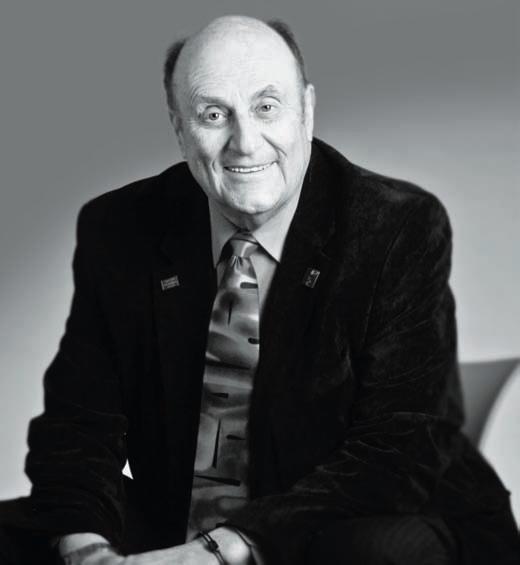
Learn how you can include Emory in your estate plans, visit www.emory.edu/giftplanning or call 404.727.8875.
Plan to take the lead.




































































































 Carol Gee Former staff member, Rollins School of Public Health
Carol Gee Former staff member, Rollins School of Public Health


